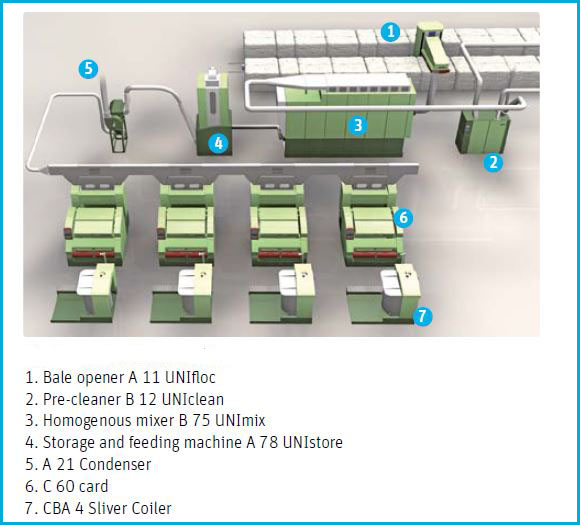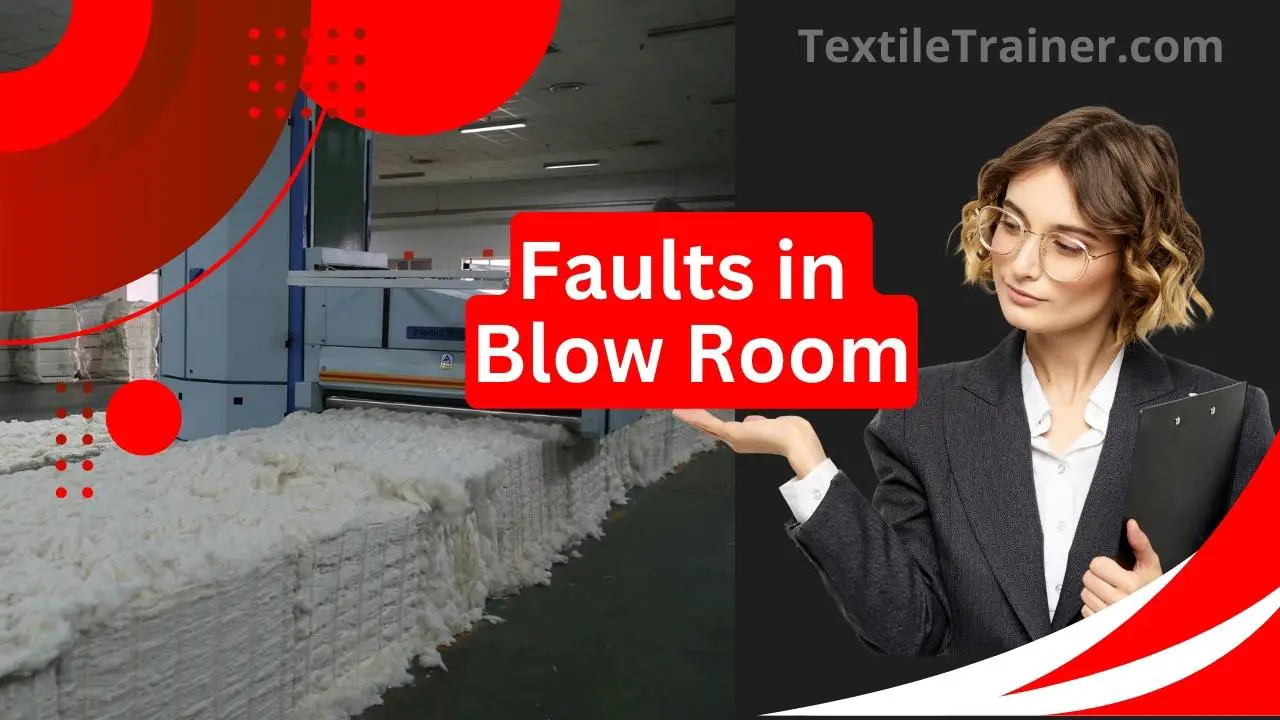In cotton processing, the blow room plays an important role in cleaning and opening cotton fibers, which ensures that subsequent processing stages are of high quality and efficient. However, like any complex machinery, the blow room is susceptible to a number of faults, which can hinder its performance and disrupt the cotton processing process as a whole.
In this article, we will explore 15 common faults that frequently occur in blow rooms and provide effective remedies to address them. Cotton processing facilities can improve productivity, maintain consistent fiber quality, and optimize blow room operations by understanding these faults and implementing the suggested solutions. The faults discussed in this article encompass a wide range of blow room components, including feeders, cleaners, beaters, and transport systems. The causes and potential consequences of each fault are presented in detail. Also, we will provide practical remedies and best practices so that the issues can be rectified and smooth operations can be ensured.

Defects/Faults in Blow Room:
There are a number of major defects or faults that may occur in the blow room, including the following:
- Dirty lap.
- Defective selvedge.
- Barrel shaped lap.
- Soft lap.
- Uneven lap.
- Split lap.
- Licking lap.
- Conical lap.
- Irregular lap.
- Low cleaning efficiency.
- Nep formation in blow room.
- Riches droppings.
- Formation of cat’s tail.
- Holes in lap.
- Patchy lap.
Now, we will discusses all above mentioned faults in blow room with their effectives remedies.
1. Dirty Lap:
There are several causes of dirty laps in the blow room, including insufficient dust removal. Dust and impurities present in cotton fibers can accumulate and contaminate the lap, resulting in lower quality laps.
Cause:
- There is not enough suction power in the blow room
- Suction settings are not adjusted properly
- Lack of regular cleaning or replacement of filters results in clogged filters
Remedy:
- Ensure adequate airflow by optimizing suction settings
- Ensure that the suction system is regularly maintained and cleaned to prevent dust buildup
2. Defective Selvedge:
It is usually caused by accumulation of waste in the holes on the sides of the cages, which weakens the air suction on the sides of the cages, resulting in irregular depositions on the walls of the cage.
Cause:
- There is an accumulation of waste on the sides of the grid bars, cages, or calender rollers, preventing the smooth flow of material.
- There is a rough spot on the side of the feed plate where the material is delivered to the calender rollers.
- Selvedge guides are not set correctly.
- Faulty cage and faulty surface of lattice of blow room machineries.
Remedy:
- Proper maintenance of under cage of machines.
- Regular clean the surface of lattice.
3. Barrel Shaped Lap:
When the thickness of a lap in the middle of the lap is greater than the thickness of a lap at the border sides of the lap, then we refer to this lap as a barrel shape lap.
Cause:
- Due to excessive fan speed, more fiber is drawn in the middle position of the cage because there is more air suction.
- The cage has accumulated dirt on both sides.
Remedy:
- It is important to control the fan speed.
- A cage must be cleaned after a certain period of time.
4. Soft Lap:
A soft lap is characterized by a reduced firmness or compactness of the cotton fibers, which can negatively impact the quality of the end product during subsequent processing. There are several causes of soft laps, including:
Cause:
- There is a low pressure on the calendar roller.
- Relative humidity is lower.
- A greater amount of trash is contained in rollers.
Remedy:
- It is important to control the pressure of the calendar.
- There should be a control over relative humidity.
- The cleaning should be done correctly.
5. Uneven Lap:
The term uneven lap refers to a lap that has variations in thickness or density across its width. This can negatively affect downstream processing and final product quality.
Causes:
- Feeding of material in an uneven manner.
- There is a problem with the regulating motion.
- improper machine maintenance.
Remedy:
- Material must be fed evenly.
- Bale opening should be connected
- Machine maintenance should be performed properly
6. Split Lap:
In terms of production, a split lap refers to a lap that has a visible separation or split along its length, which can affect the quality of the finished product.
Cause:
- There is a low pressure on the rollers of the calendar.
- The blow room section has a low temperature.
- Variation in surface speed between top and bottom cages.
Remedy:
- It is important to maintain the proper pressure on the calendar roller
- Make sure the blow room is at the right temperature
7. Licking Lap:
A licking lap occurs when the cotton fibers in the lap do not have sufficient cohesion, resulting in easy unraveling or separation during subsequent processing.
Cause:
- Calendar roller pressure is low.
- Fan speed that is too high.
- The roller motion setting is incorrect.
- Cotton with a low opening.
- use soft waste at greatest rate with general cotton.
Remedy:
- Maintain a proper fan speed.
- Calendar roller pressure should be proper.
- The cotton should be opened properly.
- Speed of the fan should be correct.
8. Conical Lap:
The term conical lap refers to a lap with a conical shape in the blow room with varying thickness and density. The lap can become conical if its width increases or decreases as it progresses with respect to its initial width. This can lead to difficulty in downstream processing and negatively impact the final product’s quality.
Cause:
- Due to fan speed variations, the air suction at the cage varies, resulting in uneven material draw.
- Variation in pressure on both sides of the calendar roller.
- There is a dirt drain on one side of the cage.
- One side has more air intelligence.
Remedy:
- The proper flow of air must be maintained.
- Pressure must be controlled on calendar rollers.
- Cages must be cleaned after a certain period of time.
9. Irregular Lap:
The lap must be of a specific shape, length, and weight per unit length, and if the lap length is less than the lap length required then it is termed an irregular lap which does not adhere to the required length.
Cause:
- The fibers feed into the lattice unevenly.
- The presence of small, weak, and immature fibers in lap fibers during mixing.
- The cage and swing door are defective, as well as the regulating motion.
- Machines that are not properly maintained.
Remedy:
- Ensure an even feed of fibers to the lattice.
- A perfect regulating motion must be ensured
- Maintenance of machines should be done properly.
10. Low Cleaning Efficiency:
An inefficient process of removing impurities from cotton fibers in the blow room is called low cleaning efficiency in the blow room. Cotton can become contaminated as a result, causing problems during the subsequent processing stages and a decrease in product quality.
Cause:
- Lower extraction of wastes than required for the mixing, considering the trash content.
- Low cleaning efficiency can be caused by insufficient waste removal.
- Lower beater speeds can reduce cleaning efficiency.
- When the feed roller doesn’t grip properly, cleaning efficiency can be reduced.
- The efficiency of cleaning can be affected by dull or blunt beaters.
Remedy:
- To ensure optimal performance and speed, check and correct the beater settings.
- Close the air-inlets under the grid bars on the cotton entry side and open them on the delivery side.
- The fan speed following the beaters should be reduced by 100 to 200 RPM.
11. Neps Formation in Blow Room:
Fiber neps and seed coat neps are fiber entanglements. Most opening and cleaning machines in the blow room process double the number of fiber neps. The actual increase in neps depends on the aggressiveness of the cleaning machine’s components.
Cause:
- There are blunt beaters in the blow room.
- The speed of the beater is higher.
- A lower fan speed or an incorrect fan-to-beater speed ratio.
- High-moisture cotton or low-moisture cotton.
- Beater and feed roller should be set closer together.
- Immature fibers are present.
- Pneumatic transport ducts that are too long and excessively bent.
Remedy:
- Improve the performance of blunt beaters by sharpening or replacing them.
- The beater speed should be adjusted to an optimal level.
- Maintain an appropriate fan-to-beater speed ratio.
- Cotton should maintain a proper moisture content.
- Mixing soft waste should be controlled and reduced.
12. Riches Droppings:
The lint percentage in the waste under any beater should be reduced to less than 40% in order to ensure that there is a low amount of lint or fibrous matter in the waste. Normally, the lint percentage in waste under any beater should not exceed 40%.
cause:
- The grid bar is set too close to the beater when the speed of the beater is high.
- Roll to beater setting with wide feed.
- Material plucking in lumps due to inadequate weighing of the feed roller.
- The angle between grids is too wide.
- Setting the waste plate high.
- Using short waste plates.
Remedy:
- Grid bar distance should be adjusted based on beater speed.
- Improve material distribution by optimizing feed roll to beater setting.
- Feed rollers should be weighed properly to prevent lumps.
- Make sure grid angles are optimal for waste separation.
- To reduce droppings richness, lower the waste plate setting.
- To prevent rich droppings, use longer waste plates.
13. Formation of Cat’s Tail:
We get this defect when the material movement is less and the cotton is overbeaten.
Cause:
- Material movement is insufficient.
- Cotton is overbeating.
- Beater edges that are dull or worn.
- The fan speed is insufficient.
- There is insufficient air inlet below the grid bar area of cotton entry.
- Striping knife open and beater set incorrectly.
Remedy:
- To avoid cat’s tails, increase material movement.
- Adjust the beater settings and speed to avoid overbeating cotton.
- Beater edges should be sharpened.
- Improve airflow by increasing fan speeds.
- Improve material separation by increasing air inlet below the grid bar.
- Adjust the beater setting after closing the striping knife.
14. Holes in Lap:
These causes can be addressed and the appropriate remedies applied to minimize lap holes, ensuring lap integrity and preventing issues in subsequent processing processes.
cause:
- Holes in the lap can result from damaged cages in the blow room.
- Holes can form when there is too much tension draft between the shell roller and the calendar roller.
Remedy:
- To prevent holes from occurring in the blow room, repair or replace damaged cages.
- To avoid the formation of holes, adjust tension draft between shell roller and calendar roller.
15. Patchy Lap:
Patchy laps can be minimized in the blow room by addressing these causes and implementing the corresponding remedies. This will result in better lap quality and smoother downstream processing.
cause:
- Patchy laps can be caused by insufficient opening of cotton tufts.
- When the feed roller and beater are not set correctly, patchiness can occur.
- Patchy laps can be caused by obstructions in the cage.
- A cage with poor suction can result in inadequate fiber opening and patchy fibers.
Remedy:
- Cotton tufts should be properly opened to promote uniform fiber distribution.
- For optimal fiber feeding and distribution, adjust the feed roller and beater settings.
- Make sure there are no obstructions in the cage so fibers can flow smoothly and evenly.
- Reduce patchiness and enhance fiber opening in the cage by improving the suction.
Conclusion:
It is possible for cotton processing facilities to optimize their blow room operations, increase productivity, and maintain a consistent fiber quality by understanding these faults and implementing the suggested remedies. These problems can be prevented and resolved by regular maintenance, proper machine settings, and adherence to recommended guidelines. I tried to my best described the defects and remedies in blow room.
References:
- Chowdhury, M. F. (2016). Manual of Short Staple Spinning. Dhaka: Granthanir Prokashoni.
- Corbman, D. P. (1983). Textiles Fiber to Fabric. NewYork: Mary McGarry.
- Hossain, M. S. (2014). Introduction to Textile Engineering. Dhka: Books Fair Publications.
- Kadolph, S. J. (2006). Textiles. New Delhi: Dorling Kindersley India Pvt. Ltd.
- Klein, W. (2016). The Rieter Manual of Spinng, Volume-II. Wintherthur: Rieter Machine Works Ltd.






